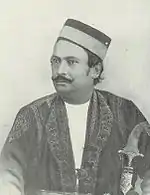Dakshinaranjan Mukherjee
Raja Dakshinaranjan Mukherjee (Bengali: দক্ষিণারঞ্জন মুখার্জ্জী) was the Taluqdar of the formerly confiscated taluq of Shankarpur in the West Bengal (1814 – 15 July 1878). He was one of the leaders of the Young Bengal group in 19th-century India. As an orator, editor of several periodicals, and a social reformer, he donated land for the Bethune School and assisted David Hare in his social works.[1] His descendants are based in India, Australia, and North America.
Dakshinaranjan Mukherjee | |
|---|---|
 | |
| Born | 1814 |
| Died | 15 Jul 1878 |
| Occupation | Social reformer |
| Spouse(s) | Jnadasundari Debi Basanta Kumari |
Early life
Jaganmohan Mukherjee, Dakshinaranjan Mukherjee's father, was originally from Bhatpara and married into the Pathuriaghata branch of the Tagore family. Following his marriage, he agreed to be a ‘ghar-jamai’, a groom who remains with his in-laws as part of their family. Little is known about Dakshinaranjan's mother.
Dakshinaranjan studied at the Hare School and, later, at Hindu College. While a student of Hindu College, he was influenced by Henry Louis Vivian Derozio, the Indian writer who created the Young Bengal movement. When his friend Krishna Mohan Banerjee was turned out of his house for converting to Christianity, Mukherjee provided him protection and support.[1]
Activities at Kolkata
Sengupta, Nitish
While a student, Mukherjee published the magazine Jnananneswan in 1831;[3] the following year the magazine was published in two languages. He spoke against suppression of newspapers by the government. He was one of main initiators for the establishment of the British Indian Association and contributed regularly to the Bengal Spectator. He practiced as a lawyer and was the first Indian to be appointed as a collector of Calcutta Municipality.[4] Later he worked as the deputy collector of the Raja of Burdwan and the dewan of the Nawab at Murshidabad.[1]
He loaned Rs. 60,000 to David Hare. As Hare was unable to pay back the loan, he gave Mukherjee some land in lieu of it. Mukherjee, in turn, donated that land in 1849 to John Elliot Drinkwater Bethune for the establishment of Kolkata’s first secular school for girls.[1][5]
Personal life
After the death of Maharaja Tej Chandra Ray of Bardhaman in 1832, Mukherjee visited the family home in connection with some legal disputes. He met Tej Chandra’s young widow, Basanta Kumari, the maharaja's 8th wife, whom Mukherjee later married by registration. The episode created a sensation in Calcutta, since Mukherjee and Basanta Kumari, chose to elope, but were caught by the girl's father, Pran Chand Kapoor.[6]
Basanta Kumari, however, escaped her father's custody to reunite with Mukherjee, with whom she migrated to Lucknow in 1851. Mukherjee and his wife, who was older than he was, remained in Lucknow until the end of their lives.
Lucknow
Mukherjee prospered in Lucknow. For helping the British during the Sepoy Mutiny, he was rewarded with the Shankarpur taluk in 1859. He was made honorary assistant commissioner of Lucknow and Awadh. He started publishing Lucknow Times, Samachar Hindustani and Bharat Patrika from Lucknow. He established the Canning College at Lucknow. He was honoured with the title of 'Raja' by the Viceroy, Lord Mayo in 1871.[1]
He established the Awadh British Indian Association in 1871 and campaigned for the formation of a provincial government with equal number of nominated and elected legislators costing him some favour with the British government.[1] Dakshinaranjan Mukherjee died in Lucknow on 15 July 1878.[4]
References
- Sengupta, Subodh Chandra and Bose, Anjali (editors), (1976/1998), Sansad Bangali Charitabhidhan (Biographical dictionary)(in Bengali), Vol I, p 202, ISBN 81-85626-65-0.
- Sengupta, Nitish, (2001/2002) History of the Bengali-speaking People, p282 UBS Publishers' Distributors Pvt. Ltd., ISBN 81-7476-355-4.
- Jnananneswan sought to instruct the Hindus in the science of government and jurisprudence. Ref: Sengupta, Nitish. P 283.
- Dastider, Shipra (2012). "Mukherji, Raja Dakshinaranjan". In Islam, Sirajul; Jamal, Ahmed A. (eds.). Banglapedia: National Encyclopedia of Bangladesh (Second ed.). Asiatic Society of Bangladesh.
- Acharya, Poromesh, Education in Old Calcutta, in Calcutta, the Living City, Vol I, edited by Sukanta Chaudhuri, pp 85-94, Oxford University Press, ISBN 0-19-563696-1.
- See Gautam Bhadra, Jal Rajar Galpa: Bardhamaner Pratap Chand, [Calcutta: Ananda Publishers, 2002] [in Bengali]
